|
1.
CENTRAL/ WEST AFRICA
Prices stall as Chinese demand cools
Buying for China appears to have slowed almost to a
complete halt for the time being. The tremendous
problems caused by the recent earthquakes in Sichuan
province are seriously affecting business as all attention is
focused on providing aid to the hundreds of thousands
who have been made homeless and treating those injured.
Trade with China had already slackened and it is not clear
when a recovery might begin. Some traders believe that
this difficult period could last well into the fourth quarter.
Meanwhile, there seems little to gain from lower priced
offers as this is unlikely to stimulate trade with buyers
already in a cautious mood.
As noted previously, West African producers have
continued laying off staff and workers; some have stopped
felling altogether until their log stocks start to move out to
the ports. Others are cutting only sufficient amounts to
keep sawmills supplied.
Sawn lumber prices were are also unchanged from midmonth.
Trade remains slow and as with the log situation, it
is not clear what would trigger a resumption of normal
trade.
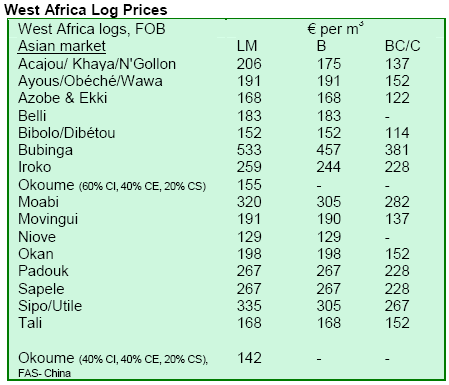

2. GHANA
Ghana cuts taxes and raises subsidies to rein in surging
prices
Afrol News and Reuters reported on the Ghanaian
government¡¯s introduction of tax breaks and subsidies to
relieve pressure from rising fuel and food prices. On 23
May, Ghana¡¯s parliament approved a measure to ¡®reduce
taxes on some fuels and key grain imports, increase
electricity subsidies and reduce operating costs for
fishermen and farmers. President Kufour said it would be
criminal for any person to re-export items once the new
measures are implemented. While he expected the
measures may attract negative comments on Ghana¡¯s
development, he said the measures were for the benefit of
the poor and vulnerable.
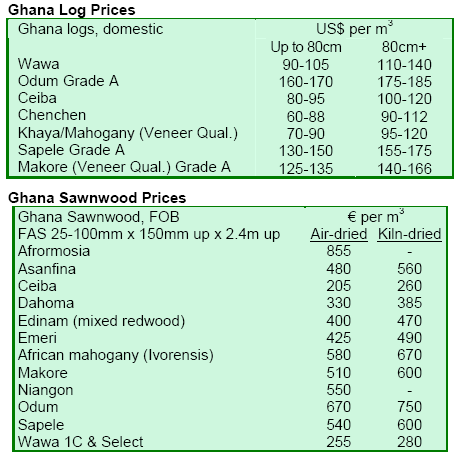

3.
MALAYSIA
Malaysian timber producers brace for turbulent market prospects
Prices for Malaysian timber products were under pressure
as crude oil prices continued to climb, with some
expecting such price rises to set off another round of hikes
in international freight charges. Local transportation and
labor costs are also rising and are already impacting
manufacturers. With falling orders from its most important
market, the US, Malaysian furniture manufacturers are
facing the prospect of a bleak period for the rest of the
current year. Malaysian furniture manufacturers are also
facing stiff competition from Vietnam.
Vietnam poised to overtake surpass Malaysia in furniture exports
Viet Nam News reported that the Vietnamese Ministry of
Industry and Trade hoped furniture exports would reach
USD5.5 billion by 2010 and would surpass China and
Malaysia in its exports to the US. Vietnam had also a
larger number of Forest Stewardship Council certified
furniture manufacturers than Indonesia and Malaysia,
giving products a greater competitive advantage in export
markets. The Vietnamese Forest Products and Wood
Industry Association said it will spend over USD300,000
to organize trade promotion programmes in an effort to
boost domestic timber export competitiveness of domestic
wood furniture manufacturers. Furniture exports in the
first four months of 2008 rose 20% from 2007 levels.
Malaysia launches timber technology and engineering portal
In its latest effort to promote Malaysian timber products,
the Forestry Research Institute of Malaysia (FRIM), the
Natural Resource and Environment Ministry and the
Ministry of Plantation Industries and Commodities have
jointly launched the Timber Technology and Engineering
Information Resources (TTEIR) portal. Bernama noted
that the portal would contain information on over 100
timber species and include special programmes to help
architects design timber components in buildings. The
portal can be found at http://timbertech.frim.gov.my.
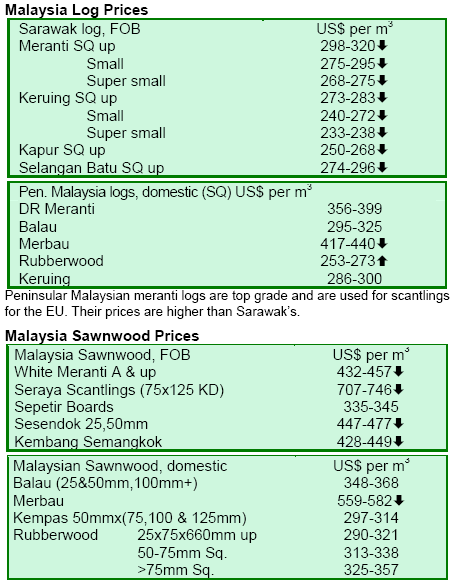
4.
INDONESIA
EC-Indonesia FLEGT Support Project targets threats to
biodiversity
Antara News reported that the EC-Indonesia Forest Law
Enforcement Governance and Trade (FLEGT) Support
Project organized a field trip for journalists to the Danau
Sentarum National Park in May 2008. The objective of the
fact finding mission was to assess the Park¡¯s biodiversity
posed by the expansion of oil-palm plantations, according
to a spokesperson for the EC-Indonesia FLEGT Support
Project in West Kalimantan. The EC-Indonesia FLEGT
Support Project aims to promote sustainable and equitable
development of forests in Indonesia. The Project together
with nine other projects funded by the European
Commission will be showcased at the annual Indonesian
Environment Week to be held at the Jakarta Convention
Center from 5-8 June 2008.
Indonesia and Malaysia set to sign MoU on haze mitigation
Malaysia and Indonesia are expected to sign a
memorandum of understanding (MoU) in June 2008 to
step up cooperative efforts to tackle haze-related problems
affecting the region. The MoU includes actions on ¡®noburning
techniques, an early warning system and peatland
management activities¡¯ in collaboration with other
stakeholders from the Riau Province, said The Star Online.
The ASEAN Meteorological Center has warned that the
effects of the La Niña weather phenomenon are expected
to wear off in the third quarter of 2008 and could result in
extremely dry conditions.
Rachmat Witoelar, the Indonesian Minister of
Environment, said Indonesia was preparing for a worstcase
scenario, yet remained committed to reducing
hotspots in Indonesia by 50% in 2009, 75% in 2012 and
95% in 2025. A Ministerial Steering Committee on
Transboundary Haze Pollution is expected to oversee the
implementation of the plan to tackle the haze problem.

5.
MYANMAR
Timber trading continues amid cyclone recovery
efforts
As aid efforts began to trickle into Myanmar, estimates of
the destruction caused by early May¡¯s Cyclone Nargis
were starting to firm up. The BBC reported that as many as
77,738 people were dead and over 55,000 were missing.
Rangoon, Pyapon, Bogale, Labutta were the towns most
affected by the cyclone. While the cyclone raced through
the major rice growing region in Myanmar, it appeared
that major teak growing areas had not been affected. The
MTE tender was held at the end of the month as usual.
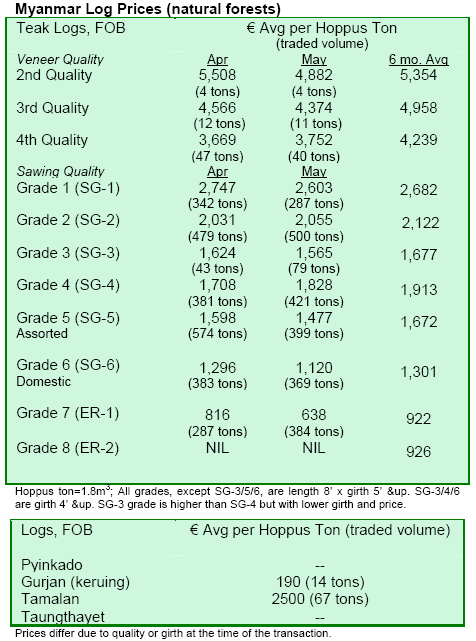
6.
INDIA
India hosts ITTO workshop to strengthen forest statistics
Recognizing the need for improvements in its statistical
reporting system for the forestry sector, India¡¯s Ministry of
Forests hosted an ITTO sponsored workshop in New
Delhi, India, from 13-16 May to assist India in meeting its
national and international reporting requirements on
forestry sector statistics. The conference was well attended
by Ministry, State/Union Territory, and private sector
representatives and provided a useful forum for
networking between the state and private sector on their
respective data needs.
Participants discussed the current status of India's forest
products statistics; regional, national and international
reporting requirements; and issues and constraints
affecting the reliability and sustainability of forest
products statistics. They also debated on how to
accommodate new and emerging elements such as nontimber
forest products, which are an important component
of India's forest economy. Workshop participants
recommended consolidating forest products statistics,
finding solutions to collecting and compiling statistics; and
clarifying roles and responsibilities toward maintaining
India's statistical system.
7.
BRAZIL
Prices rise marginally in domestic market
Prices for domestic wood products in Brazilian Reals have
not changed significantly since mid-May. However, prices
in US dollars have increased 1.1%, due to the strength of
the Brazilian Real¡¯s appreciation relative to the US dollar.
The average April 2008 exchange rate was BRL1.69 to
1USD compared to BRL2.03 to 1USD in April 2007. The
Monetary Policy Committee (COPOM) of the Central
Bank of Brazil also raised the prime interest rate by 0.5%,
the first such increase since May 2005. The rate, currently
set at 11.75%, exceeded the expectations of the industrial
sector and was unanimously approved by COMPOM.
Government to cut interest rates for timber companies
Rondonot¨ªcias reported that the Brazilian government is
expected to cut interest rates for timber companies by
50%, if the companies could show that they harvested
timber in a sustainable manner or replanted deforested
areas with native species. The measure is part of a package
of environmental proposals from the government, which
were announced on 8 May 2008. The proposals aim to
boost forest sector activities and show that forest reserve
areas in the Amazon can be profitable to rural producers
living there. The measures also aim to end proposed
changes to the Forest Code, which is under evaluation in
Congress.
The revised interest rates for forest activities will be
implemented for a longer period of time for those
companies that establish forests instead of pastures or
soybean areas on their land. In practice, landowners can
use forest area as a guarantee to obtain a loan, assuming
that the money will be used for forest activities. According
to the Brazilian Forest Service (SFB), the interest rate cut
would prove that ¡®forest replanting is not economically
feasible¡¯. SFB said the new rural credit interest rate would
be about 4% per year, in contrast to the presently varying
interest rate of 6.5% to 8.75%.
Meanwhile, the Brazilian Supreme Court (STF) also
overruled a judicial order of a federal judge suspending the
first bid for a public forest concession in the Jamari
National Forest in the state of Rondônia, Brazil. The
federal judge had contested that since the forest
concession was equivalent to public land, it would require
the approval of Congress. However, STF decided that a
¡®forest concession¡¯ could not be confused with a
¡®concession of public land¡¯, which involves the transfer of
property rights.
New Environment Minister disagrees with INPE
deforestation rate
Folha Online said Brazil¡¯s newly appointed Environment
Minister, Carlos Minc, disagreed with the deforestation
rate presented by the National Institute for Space Research
(INPE), the Brazilian governmental institute responsible
for reforestation monitoring. It was unofficially announced
that there was a 60% increase in the deforestation rate in
the state of Mato Grosso, although INPE claims not to
have released this information. Nevertheless, the new
minister reaffirmed that Mato Grosso is the area
responsible for the largest increases in deforestation,
saying that between 50% to 60% of indicators show that
deforestation is concentrated in Mato Grosso. Revised
statistics on deforestation were expected to be published
soon.
Brazil¡¯s exports slide 4.5% in April
In April 2008, the value of exports of general wood
products (except pulp and paper) fell 4.5% compared to
the same period in 2007, from USD345.3 million to
USD329.9 million. The charts below show the volume and
value of exports for April 2008 compared to the same
month a year earlier:
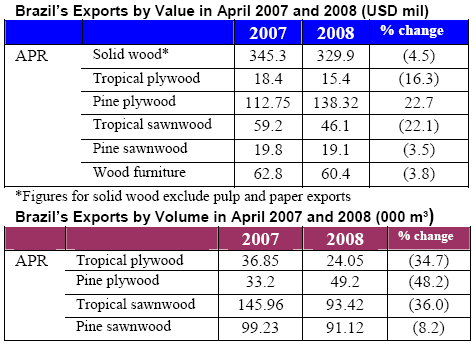
Paran¨¢ targets alternative markets to offset US losses
The state of Paran¨¢, the major Brazilian pine plywood
producer, has expanded its sales into Europe, the Middle
East and Africa, said Gazeta do Povo. In light of the 70%
reduction of US exports, the state sought alternative
markets to reduce the impact of falling exports over the
last two years. The development of civil construction has
also geared more products to the domestic market.
According to the Brazilian Association for Mechanically-
Processed Timber (ABIMCI), Europe is now the major
importer of Brazilian timber products. In the first two
months of 2008, Europe received 78.6% (246,000 m³) of
the total exported pine plywood (313,000 m³). The US
imported approximately 29,000 m³ (9.2%) and Africa and
the Middle East together imported 13,000 m³.
The slow pace of housing construction in the US and the
falling US dollar have affected foreign sales of pine
plywood, doors and frames used in civil construction.
Brazil exported approximately 1.2 million m³ of pine
plywood to the US in 2005, but exported only 347,000 m³
in 2007. In addition to the reduced demand, the
unfavorable exchange rate has made Brazilian products
less competitive in the US market, which contributed to a
decrease in exports to the US.
In the last two years, the domestic timber industry has had
to reduce production, lower costs and cut personnel due to
weakening US demand and unfavorable exchange rates,
said ABIMCI. Initially, timber producers were able to
diversify their products in the market and invest in valueadded
products so that when the crisis was full-blown it
did not severely affect Brazilian timber producers.
Nevertheless, exporting companies recognize the potential
of the domestic market is very large. For instance,
products typically used for housing in the US can also be
used for packaging in Brazil.
Forest sector in Paran¨¢ shows strong performance in 2007
Paran¨¢ Online and Celulose Online reported that the
forest sector of Paran¨¢ has showed a strong performance
over the last few years, even though the area is best known
for its agribusiness industry. Paran¨¢ exported a total of
USD1.49 billion worth of products in 2007, of which
USD1.03 billion was from the wood products industry.
Considering these results, Paran¨¢ became the second
largest Brazilian exporting state behind São Paulo.
Over the period January ¨C March 2007, pine plywood was
the most imported export product from Paran¨¢, the same
as for the corresponding period in 2007. Exports of pine
plywood from the state reached USD115 million during
the period of January ¨C March 2008, rising from USD68
million during the same period in 2007. ABIMCI also
noted that while the export value of wood products in US
dollars increased, the quantity of wood products exported
decreased. Nevertheless, the outlook for the sector remains
positive.
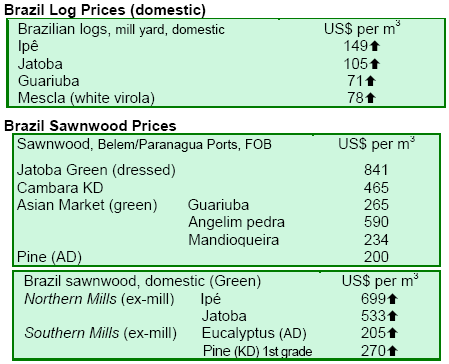
8. PERU
Peru ranks 35th on World Competitiveness Index
For the first time, Peru was listed on the World
Competitiveness Index, published in Forbes Magazine,
and ranked 35 out of 55 countries. Now that Peru has been
added to the list, experts believe there is added pressure to
improve the country¡¯s ranking by developing markets,
attracting foreign direct investment, developing
infrastructure and improving the well-being of the
Peruvian people. Economic improvement in the country
was the main contributor to the country¡¯s ranking on the
Index. Peru¡¯s economic resilience is also likely to make it
more resistant to the effects of the economic downtown in
the US and the international credit crunch. Peru aims to
achieve a 6.5% GDP growth rate and expects moderate
levels of inflation over the 2008-2009 period.
Export sector to generate more jobs for Peru
Jobs in Peru¡¯s export sector are expected to rise between
approximately 7¡ª10% this year due to growth of exports
to various international markets, said the president of
Exporters Association (ADEX) Jos¨¦ Luis Silva. This
growth is driven predominantly by the agricultural
industry and other non-traditional exports. The president
of ADEX said that of the 6,000 enterprises engaged in
foreign trade, more than 5,000 export less than
USD750,000 worth of goods a year. Nevertheless, he
noted the importance of small businesses in spurring
innovation.
Silva projected that Peruvian exports would reach USD30
billion in 2008. According to preliminary estimates from
ADEX, the country¡¯s exports during the first quarter of
2008 were USD7.3 billion, a 28% rise from the same
period in 2007. Non-traditional exports over the same
period rose 29%.
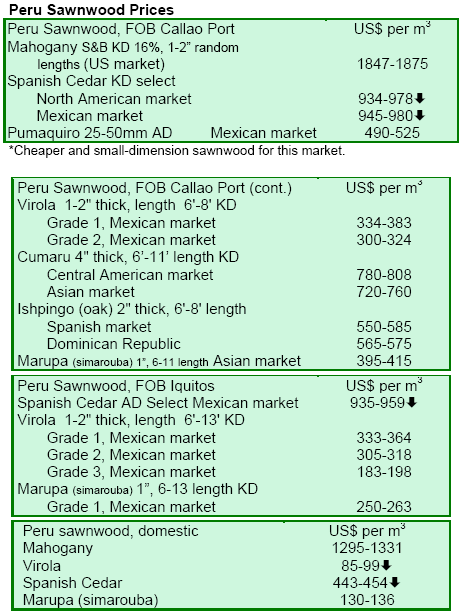
9. BOLIVIA

10.
MEXICO
CONAFOR expands budget for National Programme
for the Protection against Forest Fires
The federal government, through the National Forest
Agency (CONAFOR), has set a 550 million peso budget
in 2008 for the implementation of the National Programme
for Protection against Forest Fires, a 150 million peso
increase from the programme¡¯s budget in 2007. The
budget increase was made possible due to increased
contributions from the state, municipal governments and
the private sector.
Mexico has high potential for productive forest plantations
A representative of Commercial Forest Plantations
Department of CONAFOR, Alexander Noguez
Hernandez, announced that Mexico has the potential to
establish 12 million hectares of commercial forest
plantations. He said that at the national level, the federal
government has financed 3,629 projects in the last 10
years, covering a total area of more than 530,000 hectares.
The government has dedicated about 3.67 million pesos to
these projects. The main species planted in the country for
commercial use are Eucalyptus spp., red cedar, Gmelina
spp. and pine. Tabasco, Veracruz and Campeche contain
80% of commercial forest plantations.
11.
GUYANA
Exports of spindles surge
Guyana¡¯s exports of spindles have reached a peak in the
past fortnight. The amount of exported spindles in the last
fortnight represented more than 50% of all 2008 exports.
All spindles exported during the fortnight were sent to
Barbados, with purpleheart being the main species used
for this further processed end product. Compared with the
previous fortnight¡¯s export figures, the average price per
spindle to Barbados rose 12%.
Total export volume of doors in 2008 so far has reached
61% of year 2007 volume, while dressed lumber for 2008
has so far accounted for 53% of the previous year¡¯s total.
Dominica consumed the majority of doors, while
Barbados was the main destination for dressed lumber.
The Caribbean region has shown a continuous strong
demand over the past three years for Guyana¡¯s dressed
sawnwood products.
Guyana expects recovery from slump in production
The forest sector in Guyana is set to recover from the
slump in production, which prevailed in the first quarter of
2008. The relatively low level of production was mainly
due to poor weather conditions compounded by some
large operators that did not commence logging during this
period, since they were still engaged in finalizing their
requirements for harvesting activities planned in 2007.
These requirements included completing an Annual Plan
of Operation and conducting pre-harvest level forest
inventories. These are key requirements for all large
operators in the forest sector in Guyana and must be
completed and favorably assessed by the Guyana Forestry
Commission prior to operators commencing harvesting
activities.
With these requirements now largely completed and the
dry season having commenced, production is projected to
increase to planned levels for all products while also
compensating for the declines in the first quarter. The
slump in production seen in the first quarter was, however,
not similarly reflected in exports, as volumes for valueadded
products and price increases continually drove
export values up in key markets.

|